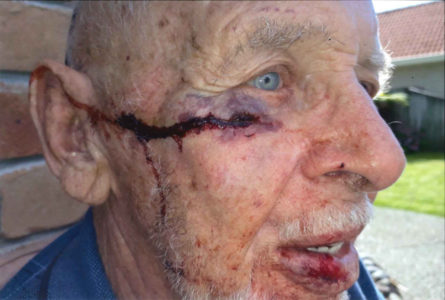
BY MARIANNE KELLY
Residents who believe their long street is turning into an arterial road are locked in a battle with Auckland Transport (AT) to get the road resurfacing rules waived.
When resealing of Kilkenny Drive in Botany started at the end of March, householders initially didn’t react when chip seal was laid. They erroneously assumed this was a base cover and that the job would be finished with smooth asphalt, as was the case in nearby stretches.
To their horror, they found out that the messy chip seal was the final product. They are upset that loose stones and gravel are strewn over footpaths and onto private properties, traffic noise has increased significantly and the road is no longer safe for children and elderly people.
Even AT was taken aback when 90-year-old Colin Stonex was rushed to hospital having sustained injury to his face, hands and knees after falling on the road, and promised to offer any assistance they could in his recovery.
A group of residents presented a petition signed by all 205 people who live along the new stretch of seal to the Howick Local Board’s May 15 meeting, also sending it to AT chief executive David Warburton.
HLB elected member Mike Turinsky attended a meeting in Kilkenny Drive the following Friday (May 19), along with 14 residents, two AT representatives, one person representing the contractor Fulton Hogan, and Labour candidate Tofik Mamedov.
Meeting organiser Tweety Tang says the residents were hoping AT would agree to fix the road.
“But we felt the AT representatives were trying to give us the stats only, such as how much it costs per square metre if they use asphalt compared with chip seal.
“We are saying the seal is not appropriate for urban development but they didn’t address the issues.”
Road resealing is part of AT’s three-year plan and includes a rule that 10,000 vehicles must pass along a road every day before it qualifies for an asphalt cover.
But the residents argue that Kilkenny Drive is used as a bypass from Chapel Road and Te Irirangi Drive, a shortcut to avoid traffic lights.
At peak times, for example from 7.15am-8.15am, Mrs Tang says she has counted 750 cars passing through.
“Parents have to get their kids to school so there is a two hour busy slot at the start and end of the working day.”
The residents have estimated that a total 8500 cars drive along the street every day which makes it a second arterial road, they argue. AT’s count, they say, is 7000-8000 a day.
Another resident, Di Silke says AT sets out its plan and budgets three years ahead.
“If we had known earlier that the job was going to be chip seal we would have said something, but we were robbed of the opportunity.
“We get our seal at the end of the three years but they have not taken into account there are two new subdivisions being developed and fed by Moyrus Crescent – a good 80 sections and all that traffic will use Kilkenny.
“They have not taken new volumes of traffic into consideration.”
Kilkenny Drive is also a catchment for Point View and Willowbank primary schools, Somerville Intermediate and Botany Downs College, as well as Dannemora kindergarten. With the noise and chips flying about, pre-schoolers are afraid to go outside to play, they say.
In response to Times questions an AT spokesperson says until chip seal has ‘bedded down’ there will be stones and increased noise.
“Kilkenny Drive has been inspected and the finish is within standard.
“Chip seal was used because it is the most cost effective solution and maximises the benefit of the New Zealand Transport Agency (NZTA) subsidy,” he says. “Chip seal costs approximately $7 per square metre, asphalt costs approximately $30 per square metre to mill and replace the existing surface.
“New Zealand has more than 92,000 kilometres of roads in its network of which about 60,000 kilometres are surfaced with chip seal.”
Chip seal, he says, was used because Kilkenny Drive falls within the recognised guidelines for a road that should be resealed with chip seal, having less than 10,000 vehicles a day using it.
“At this time it is still some way off with 7000-8000 being the current number using it. The 10,000 vehicles a day is a number set by Auckland Transport in consultation with NZTA. This is lower than the former Manukau City Council’s standard of 15,000 vehicles per day.”
The spokesperson adds that other roads in the Howick Ward of similar volumes and with chip seal are Macleans and Pigeon Mountain Roads.
The residents have written again to Mr Warburton, also to Mayor Phil Goff and the people who attended last Friday’s meeting, asking AT to address the issues raised at their meeting and those raised in their earlier petition letter.
They say the only positive responses the AT representatives gave at their meeting was acknowledging that the decision, to reduce the letter that went out to residents advising of the seal to half an A4 size, was wrong because it resulted in many unread. Also the reason AT did not respond to residents who contacted them in the early days was because its customer services system was down.









